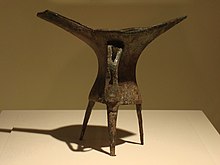Erlitou culture
34°42′6.33″N 112°41′49.48″E / 34.7017583°N 112.6970778°E

The Erlitou culture (simplified Chinese: 二里头文化, traditional Chinese: 二里頭文化, pinyin: èrlǐtóu wénhuà) is a name given by archaeologists to an Early Bronze Age urban society that existed in China from 2000 BCE to 1500 BCE.[1] The culture was named after the site discovered at Erlitou (二里頭村) in Yanshi, Henan Province. The culture was widely spread throughout Henan and Shanxi Province, and later appeared in Shaanxi and Hubei provinces. Most Chinese archaeologists[2] identify the Erlitou culture as the site of the Xia Dynasty, while most Western archaeologists remain unconvinced of the connection between the Erlitou culture and the Xia Dynasty[citation needed] since there are no extant written records linking Erlitou with the official history.
Culture
Erlitou was the largest settlement in China and even East Asia up to circa 1500 BCE. It is the earliest confirmed capital of China to date with palace buildings and bronze smelting workshops.[3]
The Erlitou culture may have evolved from the matrix of Longshan culture. Originally centered around Henan and Shanxi Province, the culture spread to Shaanxi and Hubei Province. Erlitou could be remains of Zhēnxún, the capital of the Xia Dyansty described by ancient historians. Dr. Xu Hong, head of the Erlitou Archeological Team, summarizes the disagreement with this:[3]
Was it built by people of the Xia or the Shang? Further excavation will help find the final resolution and provide new materials for periodization of the two dynasties.
Archeology

Discovered in 1959, Erlitou is the largest site associated with the Erlitou Culture. Erlitou monopolized the production of ritual bronze vessels.[4] After the rise of the Erligang culture, the site at Erlitou diminished in size but remained inhabited. The city is on the Yi River a tributary of the Luo River. The city was 2.4 km by 1.9 km; however, because of flood damage only 3 km2 are left.[3] The palaces are in the southeast portion of the city. Palace 3 is of particular interest; it was composed of three courtyards along a 150 meter axis.[3]
Chronology
Erlitou (4 phases); Erligang (2 phases)[5]
- Erlitou phase I (100 ha)
- Erlitou phase II (300 ha) A palace area of 12 ha was demarcated by four roads. It contained the 150x50 m Palace 3 and Palace 5. South of the palatial complex was a bronze foundry.
- Erlitou phase III (300 ha) The palatial complex is walled by a 2 meter thick rammed earth wall and Palaces 1, 7, 8, 9 are built. Palace 3 and 5 are abandoned and replaced by 4200 m2 Palace 2 and Palace 4.
- 1564-1521 BCE Erlitou phase IV (300 ha) Palace 6 is built as an extension of Palace 2. Palaces 10 and 11 are built.
- 1600-1450 BCE Lower Erligang phase Decline begins.
- 1450-1300 BCE Upper Erligang phase (30 ha) Erlitou returns to a village when all the palaces are abandoned.
See also
- Erligang culture
- List of Neolithic cultures of China
- Three August Ones and Five Emperors
- Xia Dynasty
- Xia Shang Zhou Chronology Project
Notes
- ^ Allan 2007; Liu & Xu 2007.
- ^ Allan 2007; Liu 2004; Liu & Xu 2007.
- ^ a b c d Li 2003.
- ^ Liu 2004, p. 231.
- ^ Liu & Xu 2007.
References
- Allan, Sarah (2007). "Erlitou and the Formation of Chinese Civilization: Toward a New Paradigm". The Journal of Asian Studies. 66. Cambridge University Press: 461–496. doi:10.1017/S002191180700054X.
{{cite journal}}: Invalid|ref=harv(help)
- Fairbank, John King and Merle Goldman (1992). China: A New History; Second Enlarged Edition (2006). Cambridge: MA; London: The Belknap Press of Harvard University Press. ISBN 0-674-01828-1
- Liu, Li (2004). The Chinese neolithic: trajectories to early states. Cambridge University Press. ISBN 978-0-521-81184-2.
{{cite book}}: Cite has empty unknown parameter:|coauthors=(help); Invalid|ref=harv(help)
- Bronze Age China, The Golden Age of Chinese Archaeology: Exhibition brochure, National Gallery of Art.
- Liu, Li; Xu, Hong (2007). "Rethinking Erlitou: legend, history and Chinese archaeology". Antiquity. 81 (314): 886–901.
{{cite journal}}:|access-date=requires|url=(help); Check date values in:|accessdate=(help); Invalid|ref=harv(help)
- Li, Jinhui (November 10, 2003). "Stunning Capital of Xia Dynasty Unearthed". China Through a Lens. Retrieved 2009-02-03.
{{cite web}}: Cite has empty unknown parameter:|coauthors=(help)
